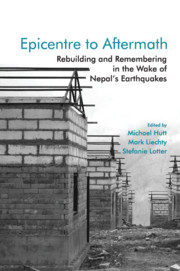14 - Gathering Absences and Presences: Memory Work, Photographs, and Affective Recovery in the Langtang Valley
Published online by Cambridge University Press: 08 July 2021
Summary
Presences, Absences, Images
It was raining outside. We huddled under one umbrella and used a flashlight as we walked toward Pasang Dhindup's temporary post-earthquake ‘home’. He opened the door, pulled out a water bottle of petrol, and we walked back to the newly-built community hall in Langtang Village. Inside were about twenty Langtangpas, almost all of them over forty years old, like most of the people living in Langtang these days. We filled the generator with petrol and the projector switched on, filling the white bed sheet we had attached to the wall with light.
The first image flickered to life: a photo of a young girl holding a wooden pail of water with a small black dog sitting at her feet. ‘Di pomo su yin pa?’ [Who is this young girl?] Everyone huddled together, pointing and discussing who she might be. Amongst their chatter in the local dialect of Tibetan, some questions in Nepali began to emerge, directed at me. ‘When was this photo taken?’ I explained that a Peace Corps Volunteer had taken the photo in the early 1960s. They shifted back to speaking in the Langtang language as I clicked through the images. ‘How did you get all these photos…?’ someone asked. I explained our project again.
We had been gathering photos from foreigners for about a year at that point, working with a handful of younger Langtangpa collaborators and keeping the broader community abreast of our progress. But this was the first time we had brought these images back to the Langtang Valley. We had been patient, waiting for the right time. Now it seemed that these projections had made this project more real to the older Langtangpas. We went through fifty images about three times that first evening. The Langtangpas were looking at the past with nostalgic eyes.
Before that night, I hadn't seen many people from the Langtangpa community wanting to look back into the past in this way. Their minds were focused on other things, especially rebuilding their homes. But now these photos seemed to help them see beyond the painful memories of the past two years since the earthquake. Everything about these photos recalled a more distant past: the Langtang of their parents and grandparents; a past that didn't hurt so much to look at.
- Type
- Chapter
- Information
- Epicentre to AftermathRebuilding and Remembering in the Wake of Nepal's Earthquakes, pp. 341 - 366Publisher: Cambridge University PressPrint publication year: 2021

